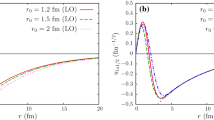Abstract
We investigate the Coulomb breakup of \(^{11}\)Be halo nuclei on a heavy target (\(^{208}\)Pb) from intermediate (70 MeV/nucleon) to low energies (5 MeV/nucleon) within the non-perturbative semiclassical and quantum-quasiclassical time-dependent approaches. The convergence of the computational scheme is demonstrated in this energy range including n + \(^{10}\)Be low-lying resonances in different partial and spin states. We have found a considerable contribution of the \(5/2^{+}\) resonance (\(E_{r}\) = 1.23 MeV) to the breakup cross section at 30 MeV/nucleon and lower, while at higher energies, the resonant states \(3/2^{-}\) and \(3/2^{+}\) (with \(E_{r}\) = 2.78 and 3.3 MeV) make most visible contributions. The obtained results are in good agreement with experimental data available at 69 and 72 MeV/nucleon. Comparison with the existing theoretical calculations of other authors for 20 and 30 MeV/nucleon is also made. The developed computational scheme opens new possibilities in the investigation of the Coulomb, as well as nuclear, breakup of other halo nuclei on heavy and light targets.












Similar content being viewed by others
Data Availability Statement
The manuscript has associated data in a data repository.
References
Al-Khalili, An Introduction to Halo Nuclei, Lect. Notes Phys. 651, 77–112 (2004). https://doi.org/10.1007/978-3-540-44490-9_3
I. Tanihata, J. Phys. G 22, 157 (1996). https://doi.org/10.1088/0954-3899/22/2/004
S. Typel, G. Baur, Phys. Rev. C 50, 2104 (1994). https://doi.org/10.1103/PhysRevC.50.2104
H. Esbensen, G.F. Bertsch, Nucl. Phys. A 600, 37 (1996). https://doi.org/10.1016/0375-9474(96)00006-1
J.A. Tostevin, S. Rugmai, R.C. Johnson, Phys. Rev. C 57, 3225 (1998). https://doi.org/10.1103/PhysRevC.57.3225
Y. Suzuki, R.G. Lovas, K. Yabana, K. Varga, Struct. React. Light Exotic Nuclei (2003). https://doi.org/10.1201/9780203168271
M. Kamimura et al., Prog. Theor. Phys. Suppl. 89, 1 (1986). https://doi.org/10.1143/PTPS.89.1
J.A. Tostevin, F.M. Nunes, I.J. Thompson, Phys. Rev. C 63, 024617 (2001). https://doi.org/10.1103/PhysRevC.63.024617
A.M. Moro, J.A. Lay, J. Gomez Camacho, Phys. Lett. B 811, 135959 (2020). https://doi.org/10.1016/j.physletb.2020.135959
D. Baye, P. Capel, G. Goldstein, Phys. Rev. Lett. 95, 082502 (2005). https://doi.org/10.1103/PhysRevLett.95.082502
L. Moschini, P. Capel, Phys. Lett. B. 790, 367 (2019). https://doi.org/10.1016/j.physletb.2019.01.041
T. Kido, K. Yabana, Y. Suzuki, Phys. Rev. C 50, R1276 (1994). https://doi.org/10.1103/PhysRevC.50.R1276
H. Esbensen, G.F. Bertsch, C.A. Bertulani, Nucl. Phys. A 581, 107 (1995). https://doi.org/10.1016/0375-9474(94)00423-K
T. Kido, K. Yabana, Y. Suzuki, Phys. Rev. C 53, 2296 (1996). https://doi.org/10.1103/PhysRevC.53.2296
V.S. Melezhik, D. Baye, Phys. Rev. C 59, 3232 (1999). https://doi.org/10.1103/PhysRevC.59.3232
P. Capel, D. Baye, V.S. Melezhik, Phys. Rev. C 68, 014612 (2003). https://doi.org/10.1103/PhysRevC.68.014612
T. Nakamura et al., Phys. Lett. B 331, 296 (1994). https://doi.org/10.1016/S0370-2693(96)01690-5
N. Fukuda et al., Phys. Rev. C 70, 054606 (2004). https://doi.org/10.1103/PhysRevC.70.054606
M. Zadro, Phys. Rev. C 70, 044605 (2004). https://doi.org/10.1103/PhysRevC.70.044605
R. de Diego et al., Phys. Rev. C 89, 064609 (2014). https://doi.org/10.1103/PhysRevC.89.064609
B. Mukeru, M.L. Lekala, G.J. Rampho, J. Phys. G Nucl. Part. Phys. 42(8), 085110 (2015). https://doi.org/10.1088/0954-3899/42/8/085110
P. Banerjee et al., Phys. Rev. C 65, 064602 (2002). https://doi.org/10.1103/PhysRevC.65.064602
G. Goldstein, D. Baye, P. Capel, Phys. Rev. C 73, 024602 (2006). https://doi.org/10.1103/PhysRevC.73.024602
J.S. Al-Khalili, J.A. Tostevin, J.M. Brooke, Phys. Rev. C 55, R1018 (1997). https://doi.org/10.1103/PhysRevC.55.R1018
C.E. Aguiar, F. Zardi, A. Vitturi, Phys. Rev. C 56, 1511 (1997). https://doi.org/10.1103/PhysRevC.56.1511
T. Fukui, K. Ogata, P. Capel, Phys. Rev. C 90, 034617 (2014). https://doi.org/10.1103/PhysRevC.90.034617
C. Hebborn, P. Capel, Phys. Rev. C 98, 044610 (2018). https://doi.org/10.1103/PhysRevC.98.044610
V.S. Melezhik, D. Baye, Phys. Rev. C 64, 054612 (2001). https://doi.org/10.1103/PhysRevC.64.054612
V.S. Melezhik, in Atoms and Molecules in Strong External Fields. ed. by P. Schmelcher, W. Schweizer (Plenum, New York, 1998). https://doi.org/10.1007/b115474
V.S. Melezhik, Phys. Lett. A 230, 203 (1997). https://doi.org/10.1016/S0375-9601(97)00250-8
V.S. Melezhik, J.S. Cohen, C.-Y. Hu, Phys. Rev. A 69, 032709 (2004). https://doi.org/10.1103/PhysRevA.69.032709
V.S. Melezhik, Phys. Rev. A 103, 053109 (2021). https://doi.org/10.1103/PhysRevA.103.053109
P. Capel, G. Goldstein, D. Baye, Phys. Rev. C 70, 064605 (2004). https://doi.org/10.1103/PhysRevC.70.064605
S.N. Ershov, J.S. Vaagen, M.V. Zhukov, Phys. Atom. Nucl. 77(8), 989 (2014). https://doi.org/10.1134/S1063778814070072
National Nuclear Data Center. https://www.nndc.bnl.gov/
V.S. Melezhik, Hyperfine Interact. 101–102, 365 (1996). https://doi.org/10.1007/BF02227645
V.S. Melezhik, C.-Y. Hu, Phys. Rev. Lett. 90, 083202 (2003). https://doi.org/10.1103/PhysRevLett.90.083202
D. Baye, P. Capel, V.S. Melezhik, Nucl. Phys. A 722, 328 (2003). https://doi.org/10.1016/S0375-9474(03)01385-X
F.F. Duan et al., Phys. Lett. B 811, 135942 (2020). https://doi.org/10.1016/j.physletb.2020.135942
V.S. Melezhik, Discrete Contin. Models Appl. Comput. Sci. (2019). https://doi.org/10.22363/2658-4670-2019-27-4-378-385
Acknowledgements
We acknowledge valuable discussion with Prof. S. N. Ershov. The work was supported by the Grant of Ministry of Science and Higher Education of the Russian Federation No. 075-10-2020-117.
Author information
Authors and Affiliations
Corresponding author
Additional information
Communicated by A. Rios Huguet.
Rights and permissions
About this article
Cite this article
Valiolda, D., Janseitov, D. & Melezhik, V. Investigation of low-lying resonances in breakup of halo nuclei within the time-dependent approach. Eur. Phys. J. A 58, 34 (2022). https://doi.org/10.1140/epja/s10050-022-00684-z
Received:
Accepted:
Published:
DOI: https://doi.org/10.1140/epja/s10050-022-00684-z




